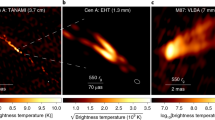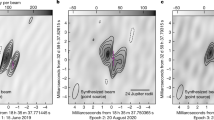Abstract
CORONAL holes have been seen in several regions of the electromagnetic spectrum. Observations have been made in the X-ray and UV (ultraviolet) regions by several groups1,2. These observations, however, can be made only from space and are not always available. Coronal holes have also been identified from spectroheliograms made from the ground3 at the 10,830 Å line of He. The 10,830 Å spectroheliograms are now obtained on a regular basis at Kitt Peak. In the radio domain several groups have attempted to identify coronal holes. These include observations at 80 and 160 MHz with the Culgoora radio heliograph4, at 10.7 GHz with the Bonn 100m antenna5, and at 85 GHz with the NRAO 11 m antenna6. Our observations reported here made at 1,420 and 2,600 MHz with the 1,000ft Arecibo radio telescope show the presence of coronal holes very clearly and provide for the first time an excellent matching of coronal hole images obtained from decimetre solar radio maps and 10,830 Å spectroheliograms.
This is a preview of subscription content, access via your institution
Access options
Subscribe to this journal
Receive 51 print issues and online access
$199.00 per year
only $3.90 per issue
Buy this article
- Purchase on Springer Link
- Instant access to full article PDF
Prices may be subject to local taxes which are calculated during checkout
Similar content being viewed by others
References
Vaiana, G. S. et al. Astrophys. J. 185, L47–L51 (1973).
Munro, R. H. & Withbroe, G. L. Astrophys J. 176, 511–520 (1972).
Harvey, J., Krieger, A. S., Timothy, A. F. & Vaiana, G. S. Skylab Solar Workshop (21, 22 March 1974).
Dulk, G. A. & Sheridan, K. V. Solar Phys. 36, 191–202 (1974).
Fürst, E. & Hirth, W. Solar Phys. 42, 156–161 (1975).
Kunda, M. R. & Liu, Sou-Yang Solar Phys. 49, 267–269 (1976).
Straka, R. M., Papagiannis, M. D. & Kogut, J. A. Solar Phys. 45, 131–139 (1975).
Wefer, F. L. & Papagiannis, M. D. The Spectrum of Coronal Hole 1 (Astr. Contrib. Boston Univ., Ser. 2, No. 65, 1977).
Krieger, A. S., Timothy, A. F. & Roelof, E. C. Solar Phys. 29, 505–515 (1973).
Sheeley, N. R., Harvey, J. W. & Feldman, W. C. Solar Phys. 49, 271–278 (1976).
Dulk, G. A., Sheridan, K. V., Smerd, S. F. & Withbroe, G. L. Solar Phys. 5, 349–367 (1977).
Author information
Authors and Affiliations
Rights and permissions
About this article
Cite this article
PAPAGIANNIS, M., WEFER, F. Coronal holes at 11.5 and 21 cm observed with the Arecibo radio telescope. Nature 273, 520–522 (1978). https://doi.org/10.1038/273520a0
Received:
Accepted:
Issue Date:
DOI: https://doi.org/10.1038/273520a0
Comments
By submitting a comment you agree to abide by our Terms and Community Guidelines. If you find something abusive or that does not comply with our terms or guidelines please flag it as inappropriate.



